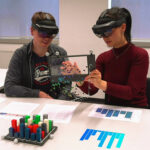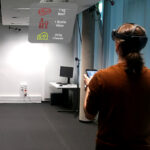We are happy to announce that two conference papers from our lab have been accepted at IEEE ISMAR 2022!
With an acceptance rate of 21%, this year’s ISMAR was again very competitive. We are glad that we are able to contribute to the community of the premier conference in the field of mixed reality with our research.
CleAR Sight: Exploring the Potential of Interacting with Transparent Tablets in Augmented Reality
In this paper, we examine the potential of incorporating transparent, handheld devices into head-mounted Augmented Reality (AR). Additional mobile devices have long been successfully used in head-mounted AR, but they obscure the visual context and real world objects during interaction. Transparent tangible displays can address this problem, using either transparent OLED screens or rendering by the head-mounted display itself. However, so far, there is no systematic analysis of the use of such transparent tablets in combination with AR head-mounted displays (HMDs), with respect to their benefits and arising challenges. We address this gap by introducing a research platform based on a touch-enabled, transparent interaction panel, for which we present our custom hardware design and software stack in detail. Furthermore, we developed a series of interaction concepts for this platform and demonstrate them in the context of three use case scenarios: the exploration of 3D volumetric data, collaborative visual data analysis, and the control of smart home appliances. We validate the feasibility of our concepts with interactive prototypes that we used to elicit feedback from HCI experts. As a result, we contribute to a better understanding of how transparent tablets can be integrated into future AR environments.
Above and Below: Investigating Ceiling and Floor for Augmented Reality Content Placement
Augmented Reality (AR) interfaces support users by providing access to digital content within real-world environments. However, displaying content at the users’ eye level might result in the occlusion of the real world. Therefore, it requires finding AR content placement areas that free the users’ field of vision. In this work, we systematically investigate two content placement areas beyond the users’ eye level: the ceiling and floor. To understand how potential users perceive virtual content on the ceiling and floor and how the content should be placed on these areas, we conducted two user studies. While the first exploratory study showed the general usefulness of either area, the second quantitative study allowed us to define optimal placement parameters regarding visibility and comfort. With insights from our studies, we provide design recommendations for future AR applications that support 2D content presentation on the ceiling and the floor.
Papers at IEEE ISMAR 2022
@inproceedings{fixme,
author = {Katja Krug and Wolfgang B\"{u}schel and Konstantin Klamka and Raimund Dachselt},
title = {CleAR Sight: Exploring the Potential of Interacting with Transparent Tablets in Augmented Reality},
booktitle = {Proceedings of the 21st IEEE International Symposium on Mixed and Augmented Reality},
series = {ISMAR '22},
year = {2022},
month = {10},
isbn = {978-1-6654-5325-7/22},
location = {Singapore},
pages = {196--205},
doi = {10.1109/ISMAR55827.2022.00034},
publisher = {IEEE}
}List of additional material
@inproceedings{satkowski2022above,
author = {Marc Satkowski and Rufat Rzayev and Eva Goebel and Raimund Dachselt},
title = {ABOVE \& BELOW: Investigating Ceiling and Floor for Augmented Reality Content Placement},
booktitle = {Proceedings of the 21st IEEE International Symposium on Mixed and Augmented Reality},
series = {ISMAR '22},
year = {2022},
month = {10},
location = {Singapore},
doi = {10.1109/ISMAR55827.2022.00068},
publisher = {IEEE}
}List of additional material
Pre-Recorded Talk, Video, Supplemental Material, Appendix PDF



